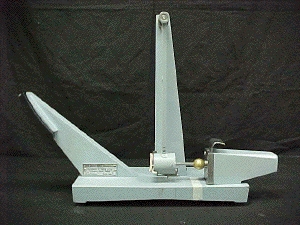Effect of gun recoil on bullet velocity.
It is often recommended that when doing ballistic experiments to measure projectile velocity, that one should fasten the gun firmly to prevent recoil. How much difference would this make in the standard ballistic pendulum experiment using the Cenco apparatus? |
 |
| The Cenco ballistic pendulum. | The Beck ballistic pendulum. |
|---|
Quantity uncertainty % uncertainty
ball mass m = 67.91 gm 0.05 gm 0.07
catcher mass M = 264.7 gm 0.05 gm 0.2
pendulum suspension length R = 71.1 cm ? 0.2 cm 0.3
height of fall h = 74.1 cm 0.1 cm 0.13 (reading uncertainty)
pendulum rise Δh = 7.25 cm 0.1 cm 1.4 (reading uncertainty)
speed of ball v = 584 cm/s, typical
Assumptions:
Conservation of momentum can be safely assumed to apply.Letting M and V represent the mass and velocity of the gun assembly, and m and v the mass and velocity of the projectilve, we can write the conservation of momentum equation:The release of the spring in the gun exerts equal force on the gun and on the projectile. This would be strictly true if the spring's mass were negligible compared to that of the bullet. It is only approximately true in the Cenco ballistic pendulum.
The potential energy, E, stored in the compressed spring is the same whether the gun is restrained or not.
| [1] |
-
MV = mv
Conservation of energy gives:
| [2] |
-
E = ½MV2 + ½mv2 .
Substitute eq. 1 into eq. 2 to eliminate V:
| [3] |
-
E = ½m2v2[1/M + 1/m] .
Rearrange:
| [4] |
-
v2 = 2E/m2[mM/(M + m)] = 2E(M/m)[1/(M + m)] .
In the limit as m/M goes to zero we have:
| [5] |
-
vo2 = 2E/m ,
which tells us that if the gun is prevented from recoiling (by having effectively very huge mass)
| [3] |
-
E = ½mvo2 .
This is an interesting and curious result. Students will readily accept it, since in this extreme case of an "infinitely" massive gun (M/m goes to infinity), they don't expect the gun to move, therefore it wouldn't have any kinetic energy. All of the spring's potential energy goes into kinetic energy of the ball. But the gun did have momentum, as we assumed at the outset, and how can it have momentum if it isn't moving? This is the pitfall in this problem, for it seems to defy common sense that something could have momentum, but no kinetic energy. The fault is the "infinity fallacy", that arises when you introduce infinity into a problem as if it were number, or worse, as if it were a number describing a physical property. See ball bouncing from a massive wall. In such cases it is best to approach the extreme case using a careful process of taking the limit as some quantity "approaches infinity" or "approaches zero".
Now let's test equation 4 with data:
When M = 2m, v = √(2/3) vo = 0.8165 vo .
When M = m, v = √(1/2) vo = 0.707 vo .
When M = 7 kg and m = 0.01 kg then vo = 0.9993 vo .
The last example is comparable to the Cenco ballistic pendulum apparatus. In this case the projectile velocity without recoil restraint isn't very significantly different from that with restraint. Gun "experts" inform me that that is also the case with rifles and other such guns, though lack of a solid recoil support can affect aiming accuracy.
Return to Ballistic Pendulum Instructor's Notes.
Return to Ballistic Pendulum experiment.
Return to Front Page.